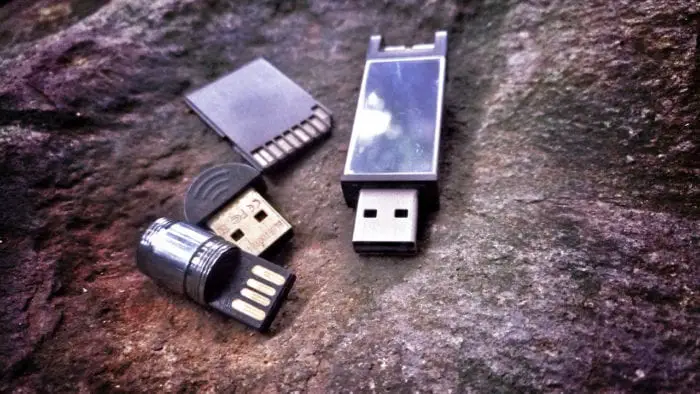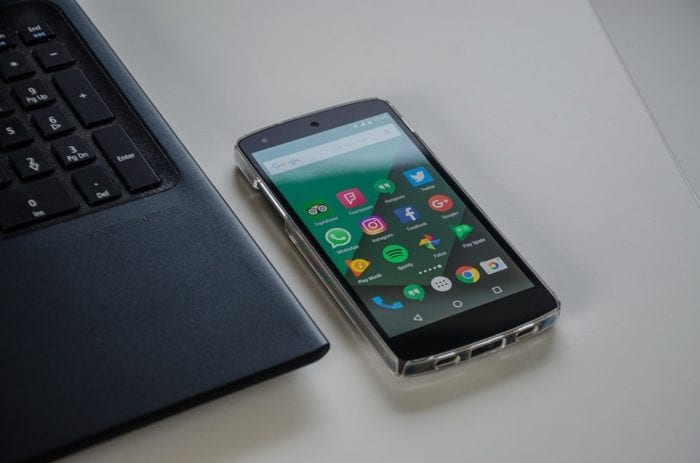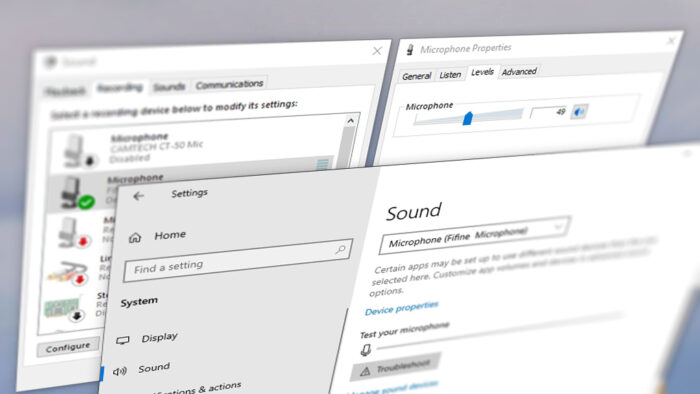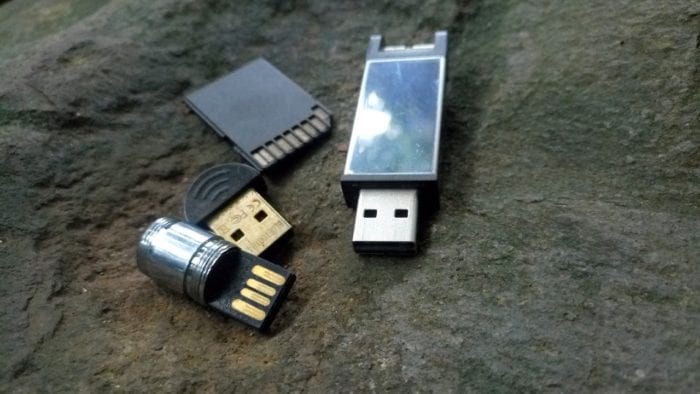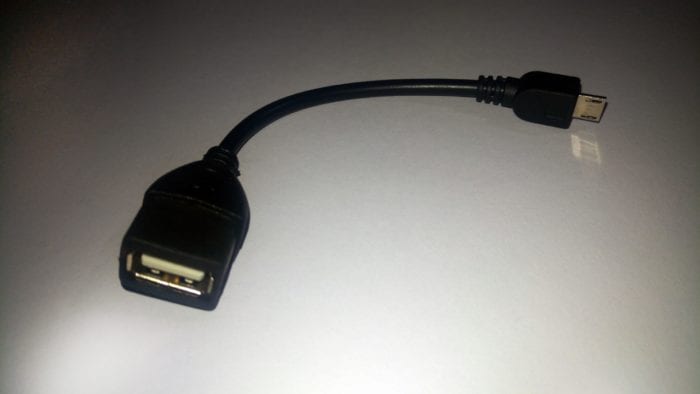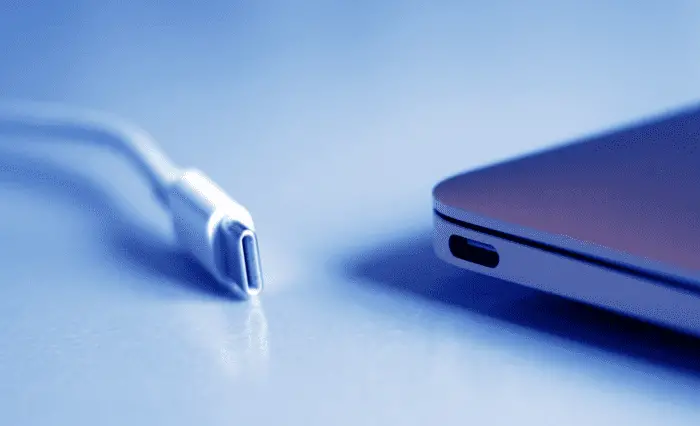SD card or USB flash drive? Both devices are relatively small and have been engineered to store data as much as possible. As the development continues, the density of data that can hold increased exponentially.
Today, SD card and USB flash drive already reach the same amount of capacity as hard drive, yet providing quicker read/write performance. But, which one is the best portable storage for your needs?
Table of Contents
SD Card — Small storage for small devices

Secure Digital Card or SD card for short was introduced in 1999 by the joint between Sandisk, Panasonic, and Toshiba to improve MultiMediaCards capability. This device is pretty small, and the thickness is about two credit cards stacked. The SD card can be distinguished by three different sizes and shapes: microSD, standard SD, and mini SD.
MicroSD – is the most popular SD card version, generally used for a smartphone, speaker, or action cam. With the size less than a penny, microSD has been vastly adopted by the mobile phone users as the most reliable external storage.
Standard SD – is more significant than microSD yet providing nearly the same capacity. This device has become a major storage component for pocket and DSLR camera.
Mini SD – is not as popular as its brother, this version rarely seen on the market these days. In fact, when you are mentioning “mini SD” people may tend to refer to standard SD.
The SD card isn’t for PC users naturally since they require a specific port to connect. Only a few modern laptops come with SD card port onboard able to access data from it. Otherwise, you may use a USB dongle.
PROS OF SD CARD:
- Smaller than a regular USB flash drive thus saved more space
- Great companion for smartphone, tablet, action camera, MP3 player, etc
- The high-speed version would also affect the device’s overall performance
- The connector pins would not easily corroded since it always stored inside the device
CONS OF SD CARD:
- Too small that could easily be lost if you accidentally fell it
- Impossible to customize its shape, style, or color
- If the connector pins rusted, you may experience sudden disconnect when using it
USB Flash Drive — Perfect to mobilize your files

The USB flash drive essentially helps the user to carry data anywhere and use it later from another computer to continue work. Since its introduction in the year 2000, the capacity it can provide is increasing gradually along with its performance.
Now, the USB flash drive maker provides USB 3.0 with a higher performance read/write data. It almost as speed as SD card but still supporting the same standard USB-A interface. Also, this device is getting smaller and thinner.
Some companies even offer customized USB flash drives to fit your taste. This specific advantage is great for a company or community that want to spread their brand awareness.
PROS OF USB FLASH DRIVE:
- Highly customizable
- Relatively faster than SD card
- Bigger capacity on the top version
- The manufacturer can add additional features
- Great companion for a laptop or PC desktop consumer
CONS OF USB FLASH DRIVE:
- Connector pins can be easily corroded since it always outside
- Storing files for a temporary time
SD card vs. flash drive in comparison
| Comparison | SD Card | USB Flash Drive |
| Year introduced | 1999 | 2000 |
| Designed for | Portable device | Computer/Laptop |
| Main purpose | Storage | Moving files |
| Highest capacity | 1 TB (SanDisk) | 2 TB (Kingston) |
| Highest theoretical speed | 290 MB/s | 640 MB/s |
| Size | 11×15 mm (microSD) | Dime coin (PKparis) |
| Lifespan | Around 10 years | 10-100 years / 100.000 cycle |
| Waterproof | Yes (some brands) | Yes (some brands) |
| Recover deleted files | Yes | Yes |
| Magnet-proof | Yes | Yes |
| Customized style | No | Yes |
| Price | From $8 | From $6 |
Gathered from many sources (updated March 23, 2020)
Conclusion: Which one the best portable storage?
Of course, both devices are great for storing and transferring files. However, you have to consider your needs before deciding.
If you looking for transferring files, I prefer a USB flash drive rather than an SD card. Since it has a bigger dimension and customization, you won’t easily lose it. That way, the USB drive is more likely to long-lasting. I have a 2GB USB flash drive from 2008 which over ten years ago and still works fine today.
In addition, modern Android phones now supported OTG connections for USB drives where you can access the file directly from your mobile phone.
Meanwhile, the SD card is good for mobile device storage, such as a camera, smartphone, or MP3 player. I have no doubt to invest in a high-quality SD card because it also affects device performance. Not only that, most DSLR cameras currently require a high-speed SD card to catch up with camera storage demand. Also, the SD card can be used as a USB flash drive with a card reader (dongle) help.
After all, both device has outstanding performance and reliability. They do their own job perfectly for the consumer. I hope this article helps you.
Future Trends in Portable Storage Devices
Emerging Technologies in SD Cards
The evolution of SD cards continues to push the boundaries of storage technology. With the introduction of SD Express and the adoption of PCIe and NVMe architectures, SD cards are now capable of delivering SSD-like performance. These advancements make them ideal for high-demand applications such as 8K video recording, multi-stream video capture, and on-device AI processing. The latest SD 9.1 specifications also include enhanced security features like self-encryption and secure boot, ensuring data safety even in sensitive environments.
USB Flash Drives: The Next Generation
USB flash drives are not being left behind. Modern USB drives now feature dual interfaces (USB-A and USB-C), making them compatible with a broader range of devices. Additionally, the shift towards USB4 technology promises transfer speeds of up to 40Gbps, which is crucial for handling large files such as 4K videos or gaming data. Manufacturers are also focusing on integrating advanced encryption and rugged designs, catering to both consumer and enterprise needs.
Sustainability and Durability
As environmental concerns grow, both SD cards and USB flash drives are seeing innovations aimed at sustainability. For example, rugged USB flash drives designed for extreme conditions are becoming more common, offering water resistance, shockproofing, and temperature tolerance. Similarly, SD cards are being developed with longer lifespans and higher durability to withstand challenging environments like military operations or outdoor adventures.
Which Should You Choose?
When deciding between an SD card and a USB flash drive, consider your specific use case:
- For mobile device storage or photography, an SD card remains the top choice due to its compact size and compatibility with cameras and smartphones.
- For frequent file transfers or high-speed data access, a USB flash drive is more suitable thanks to its faster speeds and universal compatibility.
To explore the latest options in portable storage, check out Amazon’s SD Card Collection or Amazon’s USB Flash Drive Collection.

